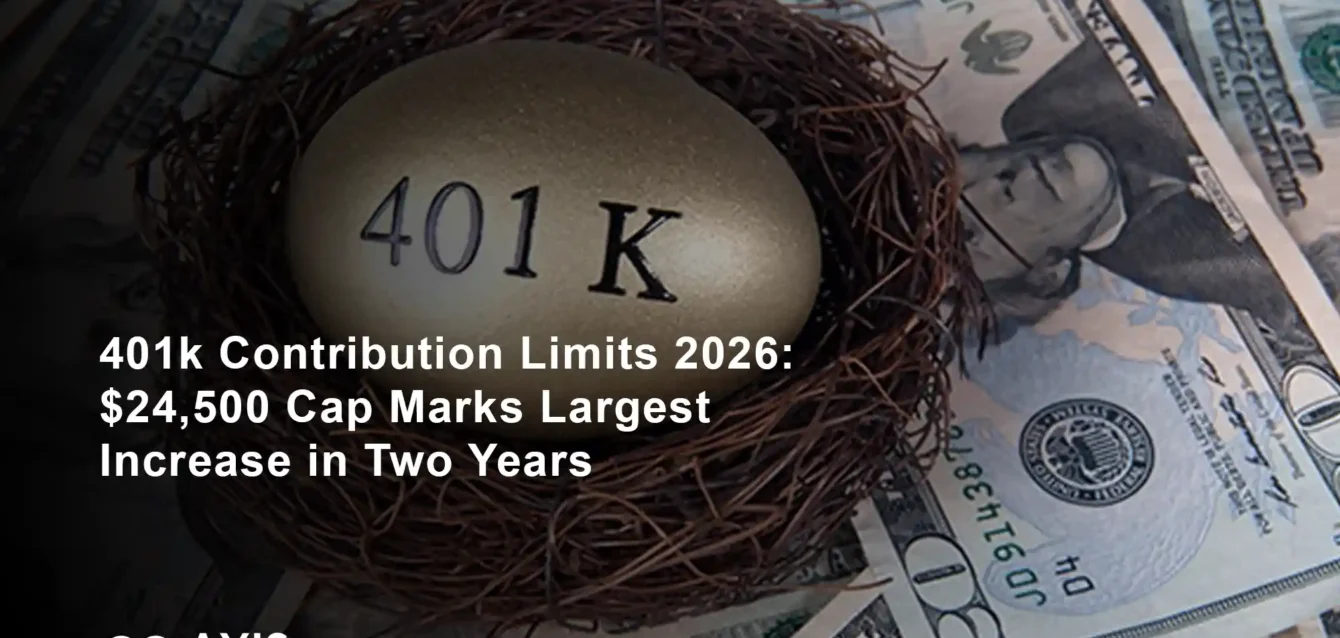401k Contribution Limits 2026
title: “401k Contribution Limits 2026: $24,500 Cap Marks Largest Increase in Two Years” meta_description: “IRS raises 401k limits to $24,500 for 2026, the biggest jump since 2023. Complete breakdown of catch-up contributions, age 60-63 super catch-ups, mega backdoor Roth strategies, and employer match calculations with real-world examples.” date: 2025-11-14 updated: 2025-11-14 author: Retirement Planning Experts keywords: 401k contribution limits 2026, IRA limits 2026, catch-up contributions, mega backdoor roth, 401k calculator, retirement savings, tax deductions
The Internal Revenue Service announced November 13, 2025, that 401k contribution limits will increase $1,000 to $24,500 for 2026, representing the most substantial jump since the $2,000 increase between 2022 and 2023. This adjustment, driven by a 2.9% cost-of-living escalation in the Consumer Price Index, arrives as Americans face record retirement savings shortfalls and only 14% of participants maximize their current 401k contributions according to Vanguard’s 2025 How America Saves report.
The new limits affect approximately 60 million Americans participating in 401k, 403b, and 457 plans, along with federal employees in the Thrift Savings Plan. More significantly, the IRS has raised catch-up contribution limits to $8,000 for workers 50 and older, while the special “super catch-up” for ages 60-63 remains at $11,250 under provisions from the SECURE 2.0 Act.
This comprehensive analysis examines every dimension of the 2026 contribution landscape: standard limits, catch-up provisions, employer match calculations, IRA coordination strategies, mega backdoor Roth techniques, high-income phase-outs, and state-specific tax considerations. We provide detailed examples showing how a 35-year-old earning $85,000 versus a 61-year-old earning $175,000 should structure contributions to maximize retirement wealth.
Complete 2026 Contribution Limits: At-a-Glance Table
| Category | 2026 Limit | 2025 Limit | Change |
|---|---|---|---|
| Employee Deferral (Under 50) | $24,500 | $23,500 | +$1,000 |
| Catch-Up (Age 50-59) | $8,000 | $7,500 | +$500 |
| Super Catch-Up (Age 60-63) | $11,250 | $11,250 | No change |
| Total Employee Max (Under 50) | $24,500 | $23,500 | +$1,000 |
| Total Employee Max (50-59) | $32,500 | $31,000 | +$1,500 |
| Total Employee Max (60-63) | $35,750 | $34,750 | +$1,000 |
| Combined Limit (All Sources) | $72,000 | $70,000 | +$2,000 |
| Combined with Catch-Up (50-59) | $80,000 | $77,500 | +$2,500 |
| Combined with Super Catch-Up (60-63) | $83,250 | $81,250 | +$2,000 |
| Compensation Limit | $360,000 | $350,000 | +$10,000 |
| Highly Compensated Employee Threshold | $160,000 | $160,000 | No change |
| IRA Contribution Limit | $7,500 | $7,000 | +$500 |
| IRA Catch-Up (Age 50+) | $1,100 | $1,000 | +$100 |
Understanding the $1,000 Increase: Inflation and Policy Context
The $1,000 jump represents the first four-figure increase since 2023, when limits rose from $20,500 to $22,500. This acceleration reflects persistent inflation despite Federal Reserve efforts to cool the economy. The IRS calculates adjustments using the Consumer Price Index for All Urban Consumers (CPI-U), specifically comparing third-quarter 2024 averages to third-quarter 2025 averages.
Historical Context: 401k Limit Evolution
| Year | Employee Limit | Increase | % Change |
|---|---|---|---|
| 2020 | $19,500 | – | – |
| 2021 | $19,500 | $0 | 0% |
| 2022 | $20,500 | $1,000 | 5.1% |
| 2023 | $22,500 | $2,000 | 9.8% |
| 2024 | $23,000 | $500 | 2.2% |
| 2025 | $23,500 | $500 | 2.2% |
| 2026 | $24,500 | $1,000 | 4.3% |
The pattern reveals that limits held flat during the low-inflation 2021 period, then surged dramatically in 2023 as inflation peaked above 8%. The current $1,000 increase signals continued elevated costs despite moderating inflation, now running at approximately 3% annually.
For context, someone who consistently maxed out contributions starting in 2020 has deferred $139,500 over seven years. If they continue at the 2026 limit, their eight-year total reaches $164,000 in tax-deferred contributions, excluding any investment growth or employer matching.
Age-Specific Strategies: Maximizing Your 2026 Contributions
The IRS structures contribution limits around three age bands, each with distinct strategies and tax implications.
Ages 49 and Under: Building the Foundation
Maximum Employee Contribution: $24,500
Workers in this demographic should focus on maximizing pre-tax contributions to reduce current taxable income while building compounded growth over 20-40 years. The key decision centers on traditional versus Roth 401k contributions.
Example: Sarah, Age 35, Earning $85,000
Sarah works for a technology company offering a 6% 401k match. Here’s her optimal 2026 strategy:
- Gross Annual Salary: $85,000
- 401k Contribution: $24,500 (28.8% of salary)
- Monthly Contribution: $2,042
- Employer Match (6%): $5,100
- Total 2026 Contributions: $29,600
- Tax Savings (24% bracket): $5,880
- Net Cost: $18,620
Sarah’s $24,500 contribution reduces her taxable income to $60,500, dropping her from the 24% federal bracket toward the 22% bracket depending on her other deductions. The $5,880 tax savings means her actual out-of-pocket cost is only $18,620 for $29,600 in retirement savings.
Growth Projection: Assuming 7% annual returns, Sarah’s $29,600 contributed in 2026 will grow to approximately $227,000 by age 65 (30 years). If she continues maxing out annual contributions with equivalent employer matches, she could accumulate over $2.4 million by retirement.
Ages 50-59: Leveraging Catch-Up Contributions
Maximum Employee Contribution: $32,500 ($24,500 + $8,000 catch-up)
The $8,000 catch-up provision, increased from $7,500, specifically targets pre-retirees who may have fallen behind in earlier years. This demographic often experiences peak earnings, making aggressive contributions more feasible.
Example: Michael, Age 54, Earning $135,000
Michael manages a manufacturing facility and has participated in his 401k sporadically over his career. He now wants to accelerate savings:
- Gross Annual Salary: $135,000
- 401k Contribution: $32,500 (24.1% of salary)
- Monthly Contribution: $2,708
- Employer Match (4%): $5,400
- Total 2026 Contributions: $37,900
- Tax Savings (32% bracket): $10,400
- Net Cost: $22,100
Michael’s situation demonstrates the power of catch-up contributions for higher earners. His $10,400 tax savings offsets nearly one-third of his total contribution cost. Additionally, if he maintains this contribution rate from age 54 to 65, he’ll accumulate approximately $700,000 in his 401k, assuming 7% returns and consistent employer matching.
Critical Consideration: Starting in 2026, high earners (those with W-2 wages exceeding $145,000 in the prior year) must make all catch-up contributions as designated Roth contributions rather than pre-tax. This provision, enacted via SECURE 2.0, affects Michael’s strategy. His $8,000 catch-up must go into a Roth 401k, meaning no tax deduction on that portion, but tax-free withdrawals in retirement.
Ages 60-63: The Super Catch-Up Sweet Spot
Maximum Employee Contribution: $35,750 ($24,500 + $11,250 super catch-up)
The SECURE 2.0 Act introduced this enhanced catch-up specifically for workers in their early 60s, recognizing that many people experience peak earnings and face looming retirement during these years. The $11,250 limit represents 150% of the standard catch-up contribution.
Example: Patricia, Age 61, Earning $175,000
Patricia serves as a senior hospital administrator planning to retire at 66. She and her spouse own their home mortgage-free, allowing maximum retirement savings:
- Gross Annual Salary: $175,000
- 401k Contribution: $35,750 (20.4% of salary)
- Monthly Contribution: $2,979
- Employer Match (5%): $8,750
- Total 2026 Contributions: $44,500
- Tax Savings (32% bracket): $11,440 (on first $27,750, assuming Roth required on catch-up)
- Net Cost: $24,310
Patricia’s strategy requires careful navigation of the SECURE 2.0 Roth catch-up requirement. Her $24,500 standard contribution can remain pre-tax, but her $11,250 super catch-up must be designated Roth (since she exceeded $145,000 in prior-year W-2 wages). This creates a hybrid tax strategy:
- Pre-Tax Contribution: $24,500 (tax deduction)
- Roth Catch-Up: $11,250 (no current deduction, but tax-free in retirement)
- Blended Tax Savings: Approximately $7,840
Patricia benefits from tax diversification. Her pre-tax balance will support required minimum distributions (RMDs) starting at age 73, while her Roth balance can grow tax-free indefinitely, potentially serving as a legacy asset for her children.
Five-Year Accumulation: If Patricia maintains maximum contributions through age 65, she’ll add approximately $222,500 to her 401k over five years (excluding growth and excluding employer match). With employer matching included, her total five-year contributions reach $266,750.
Employer Contributions and the $72,000 Combined Limit
While employee deferrals receive the most attention, the IRS sets a separate, higher limit on total contributions from all sources: $72,000 for 2026 (up from $70,000). This includes:

- Employee pre-tax deferrals
- Employee Roth deferrals
- Employer matching contributions
- Employer profit-sharing contributions
- Employee after-tax contributions (if plan allows)
- Forfeitures reallocated to participant
Understanding Employer Match Calculations
Most employers match a percentage of employee contributions up to a certain threshold. Common formulas include:
- Dollar-for-dollar match up to 3%: Employer matches 100% of employee contributions up to 3% of salary
- 50% match up to 6%: Employer contributes $0.50 for every $1.00 the employee contributes, up to 6% of salary (effectively a 3% employer contribution at maximum)
- Tiered match: Example: 100% match on first 3%, then 50% match on next 2%
Example: James, Age 42, Earning $95,000
James works for a company with a generous match: dollar-for-dollar up to 5% of salary.
- Employee Contribution: $24,500
- Match Percentage: 5% of $95,000 = $4,750
- Employer Match: $4,750 (since employee exceeded 5% threshold)
- Total Contributions: $29,250
- Remaining Capacity to $72,000: $42,750
James’s situation highlights a common misconception. Many employees believe “maxing out” means contributing $24,500, but technically the “maximum” is $72,000 when combining all sources. The $42,750 gap represents potential after-tax contribution space (if his plan allows), which becomes critical for mega backdoor Roth strategies discussed later.
The $360,000 Compensation Cap
The IRS limits the amount of compensation used to calculate retirement benefits to $360,000 for 2026 (up from $350,000). This means extremely high earners can’t base matching or profit-sharing contributions on income exceeding this threshold.
Example: Alexandra, Age 48, Earning $500,000
Alexandra’s compensation exceeds the cap significantly:
- Actual Compensation: $500,000
- Capped Compensation: $360,000
- Employee Contribution: $24,500
- Employer Match (6% of capped amount): $21,600
- Total: $46,100
- Unused Capacity: $25,900
Despite earning $500,000, Alexandra’s employer can only match based on $360,000. If her employer matches 6%, they contribute $21,600 rather than $30,000 (which would be 6% of her actual salary). This compensation cap particularly impacts executives and highly compensated professionals in finance, technology, and medicine.
Mega Backdoor Roth: Unlocking the Full $72,000
The mega backdoor Roth strategy allows high earners to maximize the full $72,000 contribution limit by making after-tax contributions beyond the $24,500 deferral limit, then converting those to a Roth 401k or Roth IRA.
Requirements for Mega Backdoor Roth
Your 401k plan must allow:
- After-tax contributions (distinct from Roth contributions)
- In-plan Roth conversions OR in-service distributions to roll after-tax money to a Roth IRA
According to Plan Sponsor Council of America, only 23% of 401k plans offered after-tax contributions as of 2024, and fewer still permitted the necessary conversion or distribution features. Tech companies (Google, Microsoft, Amazon, Meta, Apple) and large financial firms typically offer these provisions.
How It Works: Step-by-Step
Step 1: Max out employee deferrals ($24,500 for 2026)
Step 2: Receive employer contributions (matching and profit-sharing)
Step 3: Calculate remaining space
- Combined limit: $72,000
- Minus employee deferral: $24,500
- Minus employer contributions: (varies)
- Equals: After-tax contribution space
Step 4: Make after-tax contributions up to remaining space
Step 5: Convert immediately to Roth (within plan or via rollover to Roth IRA)
Example: David, Age 39, Earning $225,000
David works for a technology company with full mega backdoor Roth capabilities:
- Employee Deferral: $24,500
- Employer Match (4%): $9,000
- Subtotal: $33,500
- Remaining to $72,000: $38,500
- After-Tax Contribution: $38,500
- Immediate Roth Conversion: $38,500
David’s total 2026 retirement contributions:
- Pre-Tax 401k: $24,500
- Employer Match: $9,000 (pre-tax)
- Roth 401k (via conversion): $38,500
- Grand Total: $72,000
This strategy provides David with massive Roth balance accumulation. His $38,500 Roth contribution far exceeds the $7,500 Roth IRA limit, and he faces no income restrictions (unlike direct Roth IRA contributions which phase out at high income levels).
Tax Implications of Mega Backdoor Roth
The beauty of this strategy lies in its tax treatment:
- After-tax contributions: No current tax deduction (you already paid tax on this money)
- Conversion to Roth: No tax due on the principal (since it was after-tax)
- Tax on earnings: Only if earnings accumulated before conversion
The key is converting immediately (ideally each payroll period) to minimize taxable earnings. If David converts within days of each contribution, his earnings might be $10-50, generating negligible tax liability.
Long-Term Value: Assuming 7% returns over 25 years until David retires at 64, his $38,500 mega backdoor Roth contribution in 2026 will grow to approximately $209,000, all tax-free. If he repeats this annually, his Roth balance could exceed $2 million by retirement.
Limitations and Considerations
HCE Testing: Plans must pass Actual Contribution Percentage (ACP) nondiscrimination testing. If highly compensated employees (HCEs) make disproportionate after-tax contributions compared to non-HCEs, the plan may fail testing, triggering refunds.
Plan Availability: Most small business 401k plans don’t offer after-tax contributions due to administrative complexity and testing concerns.
Solo 401k Exception: Self-employed individuals with solo 401k plans avoid HCE testing entirely, making mega backdoor Roth particularly attractive for independent contractors, sole proprietors, and single-member LLCs.
IRA Contribution Limits and Coordination Strategies
While 401k limits receive more attention, IRA limits also increased for 2026:
- Traditional and Roth IRA: $7,500 (up from $7,000)
- Catch-Up (Age 50+): $1,100 (up from $1,000)
- Total Age 50+: $8,600
IRA Deductibility Phase-Outs
If you (or your spouse) participate in an employer retirement plan, your traditional IRA deduction may phase out based on Modified Adjusted Gross Income (MAGI):
| Filing Status | 2026 Phase-Out Range | Full Deduction Below |
|---|---|---|
| Single/Head of Household | $81,000 – $91,000 | $81,000 |
| Married Filing Jointly (covered by plan) | $129,000 – $149,000 | $129,000 |
| Married Filing Jointly (spouse covered, you’re not) | $242,000 – $252,000 | $242,000 |
| Married Filing Separately | $0 – $10,000 | $0 |
Roth IRA Income Limits
Direct Roth IRA contributions phase out at higher income thresholds:
| Filing Status | 2026 Phase-Out Range | Full Contribution Below |
|---|---|---|
| Single/Head of Household | $153,000 – $168,000 | $153,000 |
| Married Filing Jointly | $242,000 – $252,000 | $242,000 |
| Married Filing Separately | $0 – $10,000 | $0 |
Backdoor Roth IRA Strategy
High earners exceeding Roth IRA income limits can use the “backdoor” strategy:
Step 1: Contribute $7,500 to a traditional IRA (non-deductible) Step 2: Immediately convert to Roth IRA Step 3: Pay tax only on any earnings between contribution and conversion
Critical: This strategy works cleanly only if you have no other traditional IRA balances. The IRS “pro rata rule” requires proportional taxation based on all IRA balances combined.
Example: Rachel, Age 52, Earning $190,000
Rachel exceeds Roth IRA income limits but wants Roth savings:
- Traditional IRA Contribution: $7,500 (non-deductible)
- Catch-Up Contribution: $1,100 (non-deductible)
- Total IRA Contribution: $8,600
- Conversion to Roth: $8,600
- Tax Due: $0 on principal, minimal on any earnings
- Result: $8,600 in Roth IRA despite exceeding income limits
Rachel should file IRS Form 8606 to report her non-deductible contribution and subsequent conversion, establishing a paper trail proving the principal wasn’t taxed.
Combining 401k and IRA Strategies
Savvy retirement savers maximize both 401k and IRA limits simultaneously:
Example: Eric and Maria, Ages 55 and 53, Combined Income $245,000
Their comprehensive 2026 strategy:
Eric’s Contributions:
- 401k (with catch-up): $32,500
- Employer match (5%): $7,250
- Backdoor Roth IRA (with catch-up): $8,600
- Eric’s Total: $48,350
Maria’s Contributions:
- 401k (with catch-up): $32,500
- Employer match (4%): $5,800
- Backdoor Roth IRA (with catch-up): $8,600
- Maria’s Total: $46,900
Household Total: $95,250 in retirement savings for 2026
This aggressive strategy requires disciplined cash flow management but provides substantial tax advantages and accelerated wealth accumulation heading into retirement.
SIMPLE IRA and 403b Limits for 2026
While 401k plans dominate employer-sponsored retirement savings, other plan types serve specific sectors:
SIMPLE IRA Limits
Small businesses (100 or fewer employees) often adopt SIMPLE IRAs due to lower administrative burdens:
- Employee Contribution: $17,000 (up from $16,500)
- Catch-Up (Age 50+): $4,000 (up from $3,500)
- Enhanced Catch-Up (Age 60-63): $5,250 (unchanged)
- Total Age 60-63: $22,250
Employer Requirements: SIMPLE IRA sponsors must either:
- Match employee contributions dollar-for-dollar up to 3% of compensation, OR
- Contribute 2% of compensation for all eligible employees (regardless of employee participation)
403b Plans (Nonprofit Sector)
Teachers, healthcare workers, and nonprofit employees participate in 403b plans with identical limits to 401k plans:
- Employee Deferral: $24,500
- Catch-Up (Age 50+): $8,000
- Super Catch-Up (Age 60-63): $11,250
- Combined Limit: $72,000
Special 15-Year Rule: Employees with 15+ years of service at qualifying nonprofit organizations can contribute an additional $3,000 annually (lifetime maximum $15,000), independent of age-based catch-ups.
Example: Jennifer, Age 58, Nurse with 17 Years at Hospital
- Base Contribution: $24,500
- Age-Based Catch-Up: $8,000
- 15-Year Catch-Up: $3,000
- Total: $35,500 (plus employer contributions)
Tax Strategies: Traditional vs. Roth 401k Decisions
The 2026 limits apply identically to traditional (pre-tax) and Roth 401k contributions, but the tax implications differ dramatically.
Traditional 401k: Upfront Tax Savings
Advantages:
- Immediate tax deduction reduces current taxable income
- Particularly beneficial in high-income years
- Lowers adjusted gross income, potentially qualifying for other deductions/credits
- Allows larger contributions (after-tax equivalent)
Disadvantages:
- All withdrawals taxed as ordinary income in retirement
- Required Minimum Distributions (RMDs) starting at age 73
- No flexibility for tax-free early withdrawals (except narrow exceptions)
Example Tax Savings:
- Contribution: $24,500
- Tax Bracket: 32%
- Immediate Savings: $7,840
Roth 401k: Tax-Free Future Withdrawals
Advantages:
- Qualified withdrawals completely tax-free in retirement
- No RMDs during your lifetime (as of SECURE 2.0)
- Tax diversification strategy
- Protection against future tax rate increases
Disadvantages:
- No upfront tax deduction
- Requires after-tax income, reducing current cash flow
- Less beneficial if you expect lower retirement tax bracket
Example Tax Impact:
- Contribution: $24,500
- Tax Bracket: 32%
- Tax Paid: $7,840 (no deduction)
- Future Withdrawals: $0 tax on $24,500 plus all growth
The Optimal Strategy: Tax Bracket Arbitrage
The mathematically optimal approach involves comparing your current marginal tax rate to your expected retirement tax rate:
Favor Traditional 401k If:
- Current bracket: 32% or higher
- Expected retirement bracket: 22% or lower
- Short time horizon (retiring within 5-10 years)
- Expect to relocate to low/no-tax state in retirement
Favor Roth 401k If:
- Current bracket: 22% or lower
- Expected retirement bracket: 24% or higher
- Long time horizon (20+ years to retirement)
- Expect tax rates to increase generally
- Want tax-free legacy for heirs
Hybrid Strategy: Many financial advisors recommend splitting contributions between traditional and Roth, creating tax diversification that provides flexibility in retirement. For example:
- Traditional 401k: $15,000 (provides current tax savings of $4,800 at 32% bracket)
- Roth 401k: $9,500 (builds tax-free bucket)
- Total: $24,500
This approach hedges against uncertainty in future tax policy while optimizing current savings.
State Tax Considerations: Where You Live Matters
While federal limits apply uniformly, state tax treatment of 401k contributions varies significantly:
No State Income Tax States (No Impact)
These states impose no income tax, eliminating the state-level deduction value:
- Alaska, Florida, Nevada, New Hampshire, South Dakota, Tennessee, Texas, Washington, Wyoming
States Matching Federal Treatment
Most states allow full deductibility of traditional 401k contributions:
- California, New York, Massachusetts, Illinois, Oregon, etc. (traditional 401k contributions reduce state taxable income)
Special State Rules
Pennsylvania: Does not tax 401k distributions in retirement, making traditional contributions particularly valuable for PA residents retiring in-state.
California: High state tax rates (up to 13.3%) significantly amplify the value of pre-tax contributions. A Californian in the top bracket saves:
- Federal: 37%
- State: 13.3%
- Total: 50.3% on traditional 401k contributions
New Jersey: Excludes up to $100,000 of retirement income for seniors, reducing the retirement tax advantage of traditional contributions.
Common Mistakes That Cost Thousands
Mistake 1: Not Maxing Out the Employer Match
Failing to contribute enough to capture full employer matching is equivalent to declining free money. If your employer matches 5% and you contribute only 3%, you forfeit 2% of your salary annually.
Example: Salary of $80,000 with 5% match
- Contributing 3%: $2,400 employee, $2,400 employer = $4,800 total
- Contributing 5%: $4,000 employee, $4,000 employer = $8,000 total
- Cost of mistake: $1,600 per year, $16,000 over 10 years (excluding growth)
Mistake 2: Abandoning 401k After Job Change
Americans change jobs 12 times on average during their careers, often leaving 401k accounts behind. These orphaned accounts face higher fees and lack active management.
Solution: Roll over old 401k accounts to your current employer’s plan or to an IRA. Consolidation simplifies management and often reduces fees.
Mistake 3: Ignoring the Super Catch-Up Ages 60-63
Workers ages 60-63 have a special window to accelerate savings, yet Vanguard data shows only 16% of eligible employees make catch-up contributions at all. The super catch-up provision allows an extra $3,250 beyond the standard catch-up.
Lost Opportunity: A 61-year-old contributing $24,500 instead of the maximum $35,750 leaves $11,250 on the table. Over three years (ages 61-63), that’s $33,750 in forgone contributions, likely worth $60,000+ by age 70.
Mistake 4: Excessive 401k Loans
While 401k plans may permit loans, borrowing from retirement accounts creates multiple risks:
- Lost investment growth on borrowed amounts
- Loan repayments with after-tax dollars (then taxed again upon withdrawal)
- Default consequences if you leave your job
- Reduced retirement readiness
Statistics: 13% of 401k participants have outstanding loans according to Vanguard, with average loan balance of $10,000.
Mistake 5: Contribution Timing Errors
Contributing too much too early in the year can backfire if your employer matches only per-paycheck, not annually.
Example: Front-loading entire $24,500 in January-March means you’re not contributing during April-December, potentially missing out on matching contributions in those months.
Solution: Spread contributions evenly throughout the year to maximize employer matching, or verify your plan offers “true-up” contributions that correct for front-loading.
FAQ: 2026 401k Contribution Limits
What are the 2026 401k contribution limits?
The IRS has set the 2026 employee deferral limit at $24,500, up $1,000 from 2025’s $23,500. Workers age 50 and older can contribute an additional $8,000 catch-up for a total of $32,500. Those ages 60-63 qualify for a $11,250 super catch-up, allowing total contributions of $35,750. The combined limit including employer contributions is $72,000.
When do the 2026 401k limits take effect?
The new limits are effective January 1, 2026, and apply to contributions made during the 2026 calendar year. You have until December 31, 2026, to make contributions counting toward these limits, though some plans allow contributions until the tax filing deadline (typically April 15, 2027) for the prior year.
Can I contribute to both 401k and IRA in 2026?
Yes, you can contribute to both simultaneously. The 2026 limits are separate: $24,500 to 401k plans plus $7,500 to IRAs (or $8,600 if age 50+). However, IRA deductibility may phase out based on your income if you’re covered by an employer retirement plan. Total household contributions can exceed $80,000 for a couple maximizing both accounts.
What happens if I contribute too much to my 401k?
Excess contributions must be withdrawn by April 15 of the following year to avoid double taxation. The excess amount plus any earnings will be taxed for the contribution year. If not corrected, you’ll pay tax on the excess when contributed AND when eventually distributed. Contact your plan administrator immediately if you exceed limits.
Do employer contributions count toward the $24,500 limit?
No. The $24,500 limit applies only to employee deferrals. Employer matching and profit-sharing contributions count toward the separate $72,000 combined limit. For example, if you contribute $24,500 and your employer contributes $10,000, your total is $34,500 toward the $72,000 combined limit.
Can I contribute to multiple employer 401k plans?
The $24,500 employee deferral limit applies across ALL 401k plans combined. If you work for multiple employers, your total deferrals cannot exceed $24,500. However, the $72,000 combined limit applies separately to each employer, potentially allowing much larger total contributions if you have multiple W-2 jobs.
What is the difference between 401k and 403b limits?
For 2026, the limits are identical: $24,500 employee deferral, $8,000 standard catch-up, and $11,250 super catch-up for ages 60-63. The main difference is 403b plans (for nonprofits, schools, hospitals) may offer an additional 15-year service catch-up of $3,000 annually, which 401k plans don’t provide.
How much should I contribute to my 401k in 2026?
Financial advisors typically recommend contributing at least enough to capture full employer matching, then aiming for 15-20% of gross income total (employee plus employer). For someone earning $100,000, that means $15,000-$20,000 in total contributions. If you can afford to max out at $24,500, you’ll significantly accelerate retirement readiness.
When should I use Roth 401k instead of traditional?
Choose Roth 401k if you’re currently in a lower tax bracket (22% or below), expect higher income in retirement, want tax-free withdrawals, or anticipate tax rates rising. Traditional 401k works better if you’re in a high bracket now (32%+) and expect lower income in retirement. Many experts recommend a hybrid approach splitting contributions between both types.
What is the mega backdoor Roth for 2026?
The mega backdoor Roth strategy allows making after-tax contributions beyond the $24,500 limit (up to the $72,000 combined limit), then converting those to Roth. For 2026, you could potentially contribute up to $47,500 to Roth accounts ($24,500 regular Roth + up to $23,500 or more via mega backdoor, depending on employer contributions). Your plan must allow after-tax contributions and in-plan Roth conversions or in-service distributions.
Are catch-up contributions mandatory after age 50?
No, catch-up contributions are optional. The $8,000 catch-up for ages 50+ and $11,250 for ages 60-63 represent maximum allowable amounts, not requirements. However, if you’re behind on retirement savings, catch-up contributions provide a valuable tool to accelerate accumulation in your final working years.
What happens to 401k limits if I retire mid-year?
If you retire mid-year 2026, you can only contribute based on actual compensation earned during 2026. For example, if you earned $50,000 before retiring in June, your employer match calculations and contribution capacity are based on that $50,000, not a full-year projected salary. Plan your final contributions carefully to avoid excess contributions.
Conclusion: Maximizing Your 2026 Retirement Strategy
The $1,000 increase in 401k contribution limits to $24,500 represents a significant opportunity for Americans to accelerate retirement savings, particularly as inflation continues eroding purchasing power. Combined with the $8,000 catch-up for workers 50+ and the special $11,250 super catch-up for ages 60-63, the 2026 limits provide unprecedented capacity for tax-advantaged retirement savings.
Key takeaways for maximizing 2026 contributions:
- Contribute at minimum to capture full employer match – This remains the highest-return investment available, often providing instant 50-100% returns.
- Prioritize catch-up contributions if age-eligible – The $8,000 catch-up represents an additional $32,000 over four years (ages 50-53), likely worth $50,000+ by retirement.
- Consider mega backdoor Roth if your plan allows – High earners can potentially shelter up to $72,000 in 2026, far exceeding direct Roth IRA contributions.
- Coordinate 401k and IRA strategies – Maximizing both vehicles can push household retirement contributions above $80,000 annually for couples.
- Review traditional versus Roth allocation annually – Tax law changes, income fluctuations, and approaching retirement all affect optimal contribution type.
- Front-load if permitted, but verify matching rules – Earlier contributions provide more growth time, but ensure you don’t forfeit employer matching.
The sobering reality is that only 14% of 401k participants currently max out contributions, and the average American 401k balance at age 65 is just $272,000 according to Vanguard, far below the $1 million+ recommended by financial planners. The 2026 limit increases provide a clear path to closing this gap, but only for those who act decisively.
With Social Security facing a potential 20% benefit reduction by 2034 according to the Social Security Administration, 401k savings have never been more critical. The workers who maximize the 2026 limits, particularly those leveraging catch-up provisions and mega backdoor Roth strategies, will enter retirement with substantially more security and flexibility than those who postpone or minimize contributions.
Start reviewing your 2026 budget now to identify how you can increase 401k contributions. Even an extra $2,000 annually can mean $40,000+ more in retirement wealth over 20 years. The 2026 limits provide the framework; your commitment provides the results.
Sources:
- IRS Notice 2025-67: Official IRS 401k and IRA limits announcement
- Vanguard How America Saves 2025: Participant behavior and contribution statistics
- SECURE 2.0 Act of 2022: Legislative text for super catch-up provisions
- Social Security Administration 2024 Trustees Report: Long-term solvency projections
- Plan Sponsor Council of America 2024 Survey: After-tax contribution availability data
- Fidelity Q2 2025 Analysis: Average 401k savings rates and balances
Disclaimer: This article provides educational information only and should not be construed as tax, legal, or financial advice. Contribution limits, tax rules, and optimal strategies vary based on individual circumstances. Consult with a qualified financial advisor, tax professional, or certified public accountant before making retirement planning decisions. Tax laws are subject to change, and this article reflects rules as of November 2025.





